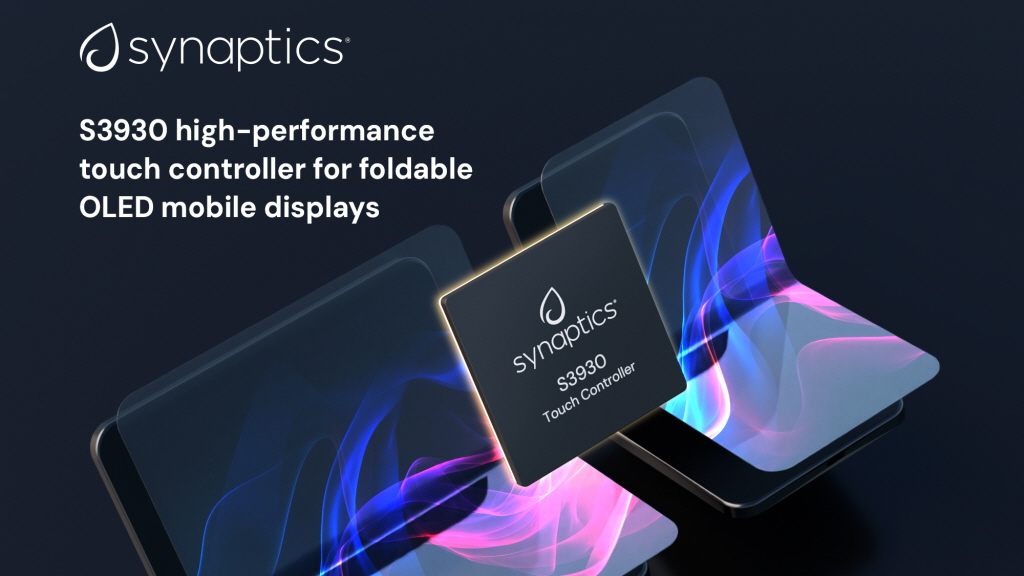폴더블 디바이스 시장이 빠르게 성장하는 가운데, 시냅틱스(Synaptics)가 새로운 터치 컨트롤러 S3930 시리즈를 발표하며, 빠르게 확장하는 폴더블 시장에서 기술 리더십을 확대했다.
S3930, 반응성·에너지 효율성·정확도 크게 향상
폴더블 디바이스 시장이 빠르게 성장하는 가운데, 시냅틱스(Synaptics)가 초소형 고성능 터치 컨트롤러를 새롭게 출시하며, 빠르게 확장하는 폴더블 시장에서 기술 리더십을 확대했다.
시냅틱스는 새로운 터치 컨트롤러 S3930 시리즈를 발표했다고 15일 밝혔다.
초소형 고성능을 갖춘 이 제품은 폴더블 디바이스 시장의 기술적 과제를 해결하기 위해 설계됐으며, 반응성과 에너지 효율성, 정확도를 크게 향상시킨 것이 특징이다.
폴더블 디스플레이 시장은 연평균 42%의 성장률을 기록하며 빠르게 확장하고 있다.
반면에 초박형 OLED 패널의 경우 높은 기생 정전 용량, 디스플레이 노이즈, 짧은 센싱 시간이 문제로 지적된다. 디스플레이가 얇아질수록 터치 감지 성능이 저하되는 현상이 발생할 수 있다.
시냅틱스의 제품 마케팅 디렉터 샘 토바(Sam Toba)는 “S3930 시리즈는 이러한 난제를 해결하기 위한 첨단 센싱 및 필터링 기술을 적용했다”며 “고객에게 보다 매끄럽고 빠른 터치 경험을 제공함으로써 향후 디바이스 설계에도 기여할 것”이라고 말했다.
S3930 시리즈의 핵심 기술은 ‘다중 주파수 영역 병렬 센싱(MFRPS, Multi-Frequency-Region Parallel Sensing)’이다.
이는 대형 터치 센서에서 센싱 버스트 횟수를 줄이고, 연속 센싱 기능을 활용해 다중 주파수 디코딩을 효율적으로 수행할 수 있도록 한다.
이로 인해 노이즈를 효과적으로 줄이면서 터치의 정확성과 반응 속도를 높일 수 있다.
또한 S3930은 고성능 프로세서를 탑재해 복잡한 알고리즘을 보다 효과적으로 처리한다.
Si-Five의 최신 E7 MCU 코어와 시냅틱스의 독자적인 하이드라(Hydra) 벡터 프로세서를 결합해 노이즈 제거 및 오터치 방지 기능을 강화했다.
특히 하이드라 벡터 프로세서는 머신러닝 알고리즘의 연산 속도를 향상시키기 위해 설계됐다.
S3930 시리즈는 초박형 베젤을 구현하면서 LTPO 및 편광판 없는 구조를 지원한다.
크기가 5.1×6.8㎜에 불과해 디바이스를 더욱 얇고 가볍게 만들 수 있으며, 접거나 펼치는 동적 환경에서도 일관된 터치 성능을 유지한다.
또한 공간 절약형 설계 덕분에 하드웨어 개발자들은 더 큰 배터리를 장착하는 등 다양한 요소를 고려할 수 있다.
